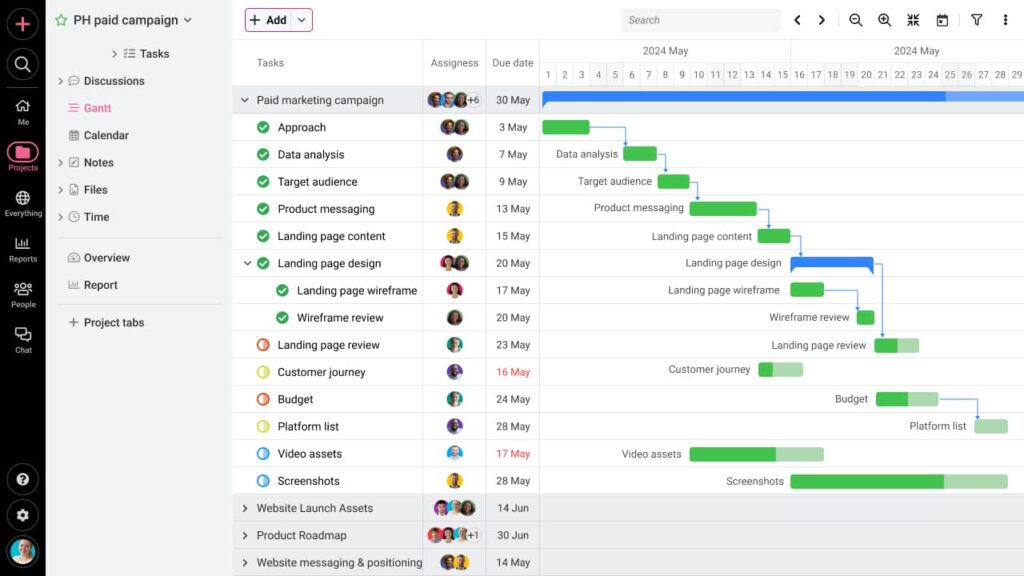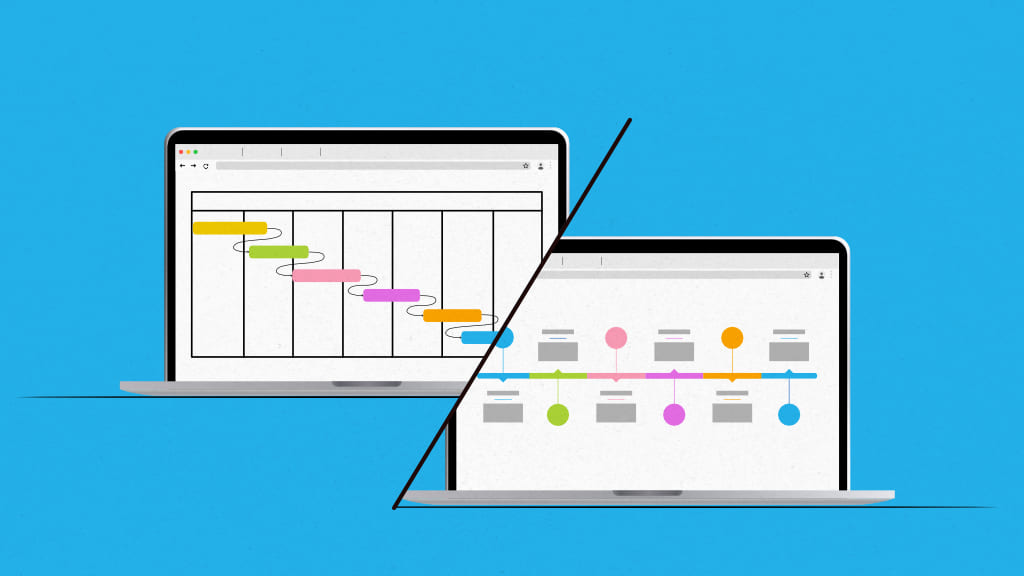Introduction
You’ve probably heard the terms “Gantt chart” and “timeline” tossed around quite a bit. Businesses use them to plan out projects and tasks, while people use them to plot out personal goals. But what are these charts used for? And how do you create one, anyway? This guide will answer those questions and more so that you can use Gantt charts and timelines in your business or day-to-day life.
What is a Gantt Chart?
A Gantt chart is a graphical representation of a project schedule, which shows the start and end dates of tasks, their duration, and the dependencies between them. The horizontal axis represents time across one or more projects. The vertical axis represents the activity of each project. Usually, you’ll see a period listed at the bottom of your Gantt chart so you know exactly how long it took to complete each task and when they started/ended about other tasks.
Why Gantt Chart is important?
- Gantt chart is a great tool for project managers and their teams to visualize their projects. They help project managers see where they are at and where they are going in the future, which is essential for any successful team.
- Gantt Charts are also helpful when you want to get a quick overview of what needs to be done, who is doing it, and when.
- If you need to see the status of multiple projects or teams at once, then Gantt charts will be very useful. This is particularly important if one part of your project relies on another part being completed first (this could be because resources are shared between projects).
- Gantt charts are great for project presentations. It helps present the status of a project by providing a visual representation of the schedule in the form of bars or rectangles with time codes on them so that everyone knows exactly where the project stands in terms of completion compared to others working on similar tasks.
- Managers can use Gantt charts to effectively communicate their goals and expectations about projects to their team.
For example, if Team A needs input from Team B before they can start work, then using a Gantt chart will help you see how long this will take. This means that if there’s an issue with getting this information from Team B by an agreed date, then it won’t affect all other activities across your organization negatively, as it would if they were all trying to do everything independently.”
What is a Timeline view?
You may have heard the term “timeline view” before, but what is it? A timeline view is a visual representation of a project—including all of its tasks and deadlines. Timelines are useful for keeping track of how far along a project you are, as well as when each task should be completed. They can help you plan out your workload or even show off your progress to clients or coworkers!
Why Timeline view is important?
The Timeline view is a visualization of your project schedule. It can be used to:
- Communicate the schedule to team members to get them excited about working on it, and keep them informed about where they are about that schedule as they work on it.
- Communicate the schedule to stakeholders (such as clients or bosses) so that they can see how things are going, when tasks will be completed, and what needs to happen next.
- Communicate the outcome of your project—namely, when it’s going live—to everyone involved (this includes yourself!).
For example, if you’re working on a website redesign for a client whose deadline is coming up soon but who hasn’t yet seen any designs from you or discussed what kind of changes might be made during development stages later on down the line (because maybe the client was busy?). Showing these timelines at each stage could help reassure client that everything is still progressing smoothly toward completion despite not having talked much lately.
Difference between the Gantt Chart and Timeline
The main difference between a Gantt Chart and a Timeline is that a Gantt Chart provides a detailed, visual representation of a project schedule, showing tasks, their durations, dependencies, and progress over time, while a Timeline offers a simplified, linear view of events or milestones in chronological order without detailing task dependencies or durations.
Gantt chart vs Timeline – Comparison table
| Feature | Gantt Chart | Timeline |
| Visual Representation | Detailed representation of tasks, durations, and dependencies | Linear progression of events or milestones |
| Task Dependencies | Yes, shows task dependencies and relationships between tasks | No, only shows events in chronological order |
| Task Duration | Clearly shows the start and end date of each task. | Focuses on event or milestone dates. |
| Complexity | High, ideal for complex projects. | Low, ideal for simpler project plans. |
| Time Representation | Time is divided into detailed segments (days, weeks, months) | Time is shown linearly, typically with major milestones or deadlines |
| Best Use Case | Complex projects with multiple tasks and dependencies | High-level project overviews, presentations, or marketing |
How to use the Timeline view for effective project presentations?
The timeline view is ideal for presenting a project plan to stakeholders. It’s easy to create and share, easy to understand, and easy to update. The timeline format allows you to add tasks, subtasks, and milestones easily. You can also assign resources and link them with task dependencies.
When should you use the Gantt chart and Timeline view?
What is the best way to use them all?
To help you decide which Gantt Chart or Timeline View is right for your project, let’s take a look at how you can use each one.
- Use the Gantt Chart for planning tasks and features, then link them together in the Timeline View. This way, you’ll see exactly how long each task takes and plan accordingly. You can also add events (e.g., meetings or deadlines) to your Timeline View for plans that are more fluid than those in a Gantt Chart.
- If you’re presenting your project plan to clients or stakeholders, show them what it will look like using the Timeline View—it provides an easy-to-digest view of tasks grouped by dates (which means no need to read through bulleted lists). And if they have questions about specific parts of the timeline, they can easily click on those days/weeks/months so they know exactly what happened during that period!
How to use the Gantt Chart in your tasks and projects?
So, you’ve got the basics down. You know when should you use Gantt charts and how it can help you manage tasks and progress. But what about when you implement it with your team? How do you go about applying this valuable tool to your project?
The first step is to brainstorm ideas for projects that could benefit from a Gantt Chart, as well as any roadblocks or red flags that might arise during or after implementation. Then, once you’ve identified which projects need organizing, create a list of all of the tasks involved in each project (make sure not to skip any details). Once those are recorded on paper, sketch out an outline of each task and its expected duration—this will become your timeline!
Next comes one of the most important steps: figuring out where each team member fits into this picture. When creating timelines like this one, I recommend dividing up responsibilities based on skill sets rather than time spent working side by side every day (which may not be possible depending on who works remotely). This way, each person gets equal responsibility without spending too much time trying their hardest only at certain times throughout their day/weekend/month/etcetera. In contrast, others get stuck doing more menial tasks but less fun ones instead (because, let’s face it: no one wants those jobs!).
This system allows everyone to get an equal share of work done without feeling left out or overwhelmed with extra work. Not everyone needs help finishing their job quickly enough before moving on to another piece.”
How to create Gantt charts and timelines in an online tool like ProofHub.

Gantt charts and timelines are both visual representations of a project timeline, but they’re used for different purposes.
Gantt charts are best suited for tasks that need to be completed in fixed periods. For example, if you need to build an app that will take one year from start to finish, you could use a Gantt chart to organize all your phases or steps and assign each person who has an assigned task with their line item on the graph.
Timelines, however, give more flexibility and allow you to highlight significant events like milestones and deadlines separately from smaller steps within the project plan. If you want people who are not involved in all stages of production – say investors or marketing teams – this may be a better way for them to understand how long things take so they have realistic expectations when planning promotional activities around product launches/new releases etc.
How to create a Gantt Chart in ProofHub
Creating a Gantt Chart in ProofHub is easy.
- Go to your project dashboard and click on the ‘Gantt Chart’ button (you’ll see this at the top of your page).
- Select the project type: Milestone or Task.
- Select a duration for your project—that’s how long it should take to complete, in days or hours.
- Give your project a name and select its start date, end date, start time, and end time.
Conclusion
We hope this article has helped you understand the difference between a Gantt chart and a timeline, as well as how you can use them to track your project’s progress better. By now, you should have learned that both of these visual aids are great tools for planning and executing your projects. However, if we had to choose one over the other, it would be none other than the Gantt chart due to its versatility in project management.

